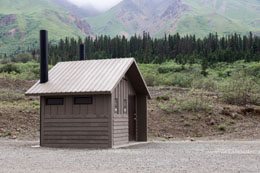A composting toilet is a human waste disposal system. Very little or no water is used in it, and composting is done by aerobic bacteria. It converts human waste into usable soil which can be used as a manure in the garden. Contrary to popular belief, these toilets are very hygienic and odorless. They are easy to build and function. The steps for building them are mentioned below.

It has been said that 'World War-III will be fought over water'. Annually a family of four requires, on an average, 100,000 liters of water for flushing. Although a majority of the earth is covered with water, most of it is unfit for human consumption and use. It's time we start conserving the water that we have. The decomposition of human excreta also takes a lot of time, when in water. At the same time, it contaminates water bodies. The composting toilet will not only help save the environment, but it will also make the earth more green. It is similar to compost bins used for kitchen and garden waste.
Here is a method of building a composting toilet. The list of the material required is as follows:
- Funnels - 2
- Buckets of capacity 5 gallons with lid - 2
- Toilet seats - 2
- Tubes - 2
- Tank - 1
- Exhaust pipe - 1
- Cement for plastering the chambers
- Dry twigs, dry leaves, and sawdust
- Lime powder
- Material for building a plinth over two chambers
Now let's look at the procedure.
- Make two chambers so that they can be used alternately, till the waste from one is converted into compost.
- Fix the seats over these chambers.
- Attach an exhaust pipe to the chamber room so that it exhausts all the odor and keeps it odor free.
- Attach the funnels to the seats. Join them with the tubes. The tubes should further be joined to the tank. The funnels are used to dispose off the urine and the waste water. This will in turn be collected by the tank.
- The water waste and urine will be mixed with water in the ratio 1:3. The same can be used to water the garden. The tank can have an opening, which opens into the flower beds. The urine does not smell as it is mixed with water.
- Attach a bucket to each of the chambers. Fill it to half of its capacity with sawdust, twigs, and dry leaves before the usage of the toilet starts.
- After usage, add some sawdust into the chamber.
- If the chamber has not been filled to its capacity and is smelling, add lime powder.
- Sawdust helps in keeping the compost moist. The human waste is low in carbon but high in nitrogen. It's the reverse case with sawdust.
- Once the first bucket is full, cover the bucket with a lid.
- Start using the second chamber. When the second bucket is also full, empty the compost from the first bucket, and use it in the garden.
- Repeat the same procedure with the second bucket.
- The buckets will take on an average, 6 to 9 months to fill up.
- Do not forget to fill the empty bucket with sawdust, dry twigs, and leaves before reuse.
- Once you empty the buckets of the compost, they can also be washed. But it is not a necessity.
- Although after a long period of time, there is a possibility that the buckets will have an odor. It is then suggested to change the buckets.
- In case the compost is not required immediately, it can be dumped in a compost pit. It will then turn into a fertilizer, which can be used as and when required.
- If the pit where the compost has been dumped starts emitting odor, turn the contents upside down. The bacteria will get the required amount of oxygen and the odor will reduce.
With the paucity of water, amount of pollution, etc., awareness should be created about composting toilets. They should become a rage of the future, making the earth a greener place to live in.






 It has been said that 'World War-III will be fought over water'. Annually a family of four requires, on an average, 100,000 liters of water for flushing. Although a majority of the earth is covered with water, most of it is unfit for human consumption and use. It's time we start conserving the water that we have. The decomposition of human excreta also takes a lot of time, when in water. At the same time, it contaminates water bodies. The composting toilet will not only help save the environment, but it will also make the earth more green. It is similar to compost bins used for kitchen and garden waste.
It has been said that 'World War-III will be fought over water'. Annually a family of four requires, on an average, 100,000 liters of water for flushing. Although a majority of the earth is covered with water, most of it is unfit for human consumption and use. It's time we start conserving the water that we have. The decomposition of human excreta also takes a lot of time, when in water. At the same time, it contaminates water bodies. The composting toilet will not only help save the environment, but it will also make the earth more green. It is similar to compost bins used for kitchen and garden waste.